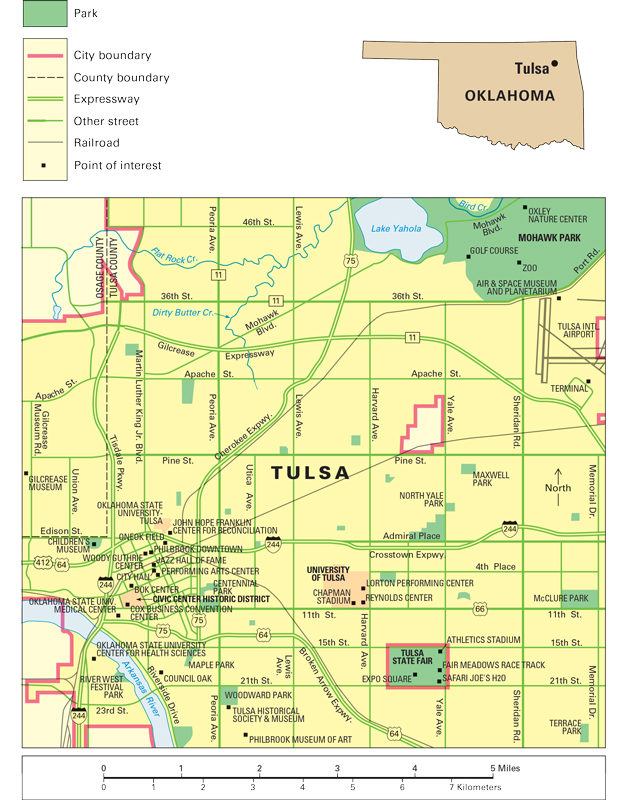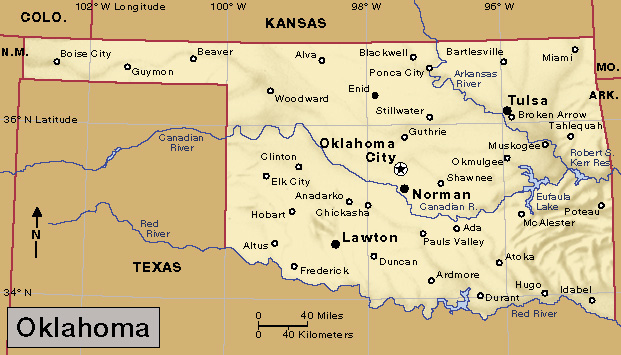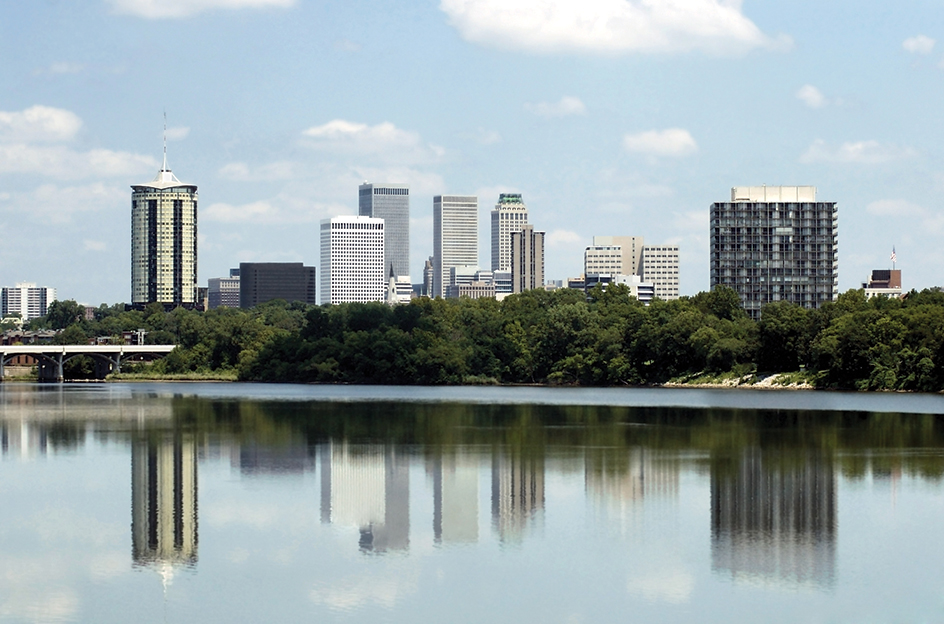Tulsa, << TUHL suh >> (pop. 413,066; met. area pop. 1,015,331), is a major center of the United States petroleum industry and the busiest port and chief manufacturing center of Oklahoma. Tulsa is the state’s second largest city. Only Oklahoma City has more people. Tulsa lies in northeastern Oklahoma along the Arkansas River.

In the 1830’s, the Creek people, a Native American group from Tallassee, Alabama, settled in what is now the Tulsa area. They named their village after their former community, but in time the name was changed to Tulsa. Construction of the first railroad to Tulsa in 1882 brought European settlers to the area. But until 1901, Tulsa remained a small village. That year, the discovery of oil in nearby Red Fork attracted many people to the area. The city then grew quickly.
The city.
Tulsa, the county seat of Tulsa County, covers 202 square miles (523 square kilometers), including 4 square miles (10 square kilometers) of inland water. The Arkansas River divides the city into two parts, the larger of which lies east of the river. Tulsa’s metropolitan area covers seven entire counties—Creek, Okmulgee, Osage, Pawnee, Rogers, Tulsa, and Wagoner.
The Tulsa Civic Center Historic District forms the heart of downtown Tulsa. This historic district includes the county courthouse, a federal office building, the main public library, and police headquarters. The Cox Business Convention Center, which has exhibit halls and an arena, also stands in this area.

Economy.
Tulsa has hundreds of manufacturing plants. The chief industries manufacture fabricated metal products and nonelectric machinery. The city is a leading manufacturer of industrial heaters and hoisting devices called winches. Other Tulsa products include transportation equipment; metals; and clay, glass, and stone articles. The city’s largest employers include American Airlines, which has maintenance and engineering centers there, and the energy and communications firm Williams Companies, Inc.

Tulsa is an administrative center of the United States petroleum industry. Tulsa serves as a major control center of the industry, with many distributors, manufacturers, producers, and research activities.
Hundreds of oil or oil-related companies maintain offices in the Tulsa area. Many of these firms have headquarters in the city.

Tulsa became a major port in 1970, after the McClellan-Kerr Arkansas River Navigation System was extended to Catoosa, 3 miles (5 kilometers) east of the city. This system links Tulsa’s port, near Catoosa on the Verdigris River, to the Mississippi River, the Gulf of Mexico, and the Atlantic Ocean. An industrial area is near the port. Many airlines use Tulsa International Airport. Freight trains also serve the city. Tulsa has one daily newspaper, the Tulsa World.
Education and cultural life.
A seven-member elected Board of Education oversees Tulsa’s public school system. The city also has a number of parochial and private schools. Colleges include the Oklahoma State University Center for Health Sciences, Oklahoma State University-Tulsa, Oral Roberts University, and the University of Tulsa.
The Gilcrease Museum features one of the world’s finest collections of Native American art and historical documents. It also exhibits the world’s largest collections of works by the American painters Thomas Moran, Frederic Remington, and Charles M. Russell. The Philbrook Museum of Art displays Italian Renaissance paintings and sculpture, Chinese jewelry, and Native American baskets and pottery. The Tulsa Ballet, the Tulsa Opera, and the Tulsa Symphony Orchestra perform regularly at the Tulsa Performing Arts Center, which has four theaters.
Tulsa’s largest park is Mohawk Park, which occupies more than 2,800 acres (1,130 hectares). It includes a golf course and a zoo. The Tulsa Municipal Rose Garden, in Woodward Park, features thousands of rose plants. The annual Tulsa State Fair begins in late September or early October at Expo Square. Expo Square includes a livestock display barn, show ring, and exhibition hall.
Government.
Tulsa has a mayor-council form of government. The voters elect a mayor to a four-year term and nine councilors to two-year terms. Tulsa gets most of its revenue from a sales tax.
History.
Several Native American tribes once hunted in the area that is now Tulsa. During the 1830’s, Creek people from Tallassee, Alabama, settled in the Tulsa area. According to tradition, a Creek leader named Archie Yahola led tribal councils under a huge tree called the Council Oak in 1836. This tree still stands on Cheyenne Avenue in Tulsa.
In 1848, Lewis Perryman of the Creek people opened a village trading post on the Arkansas River. A post office called Tulsa was established at the ranch of his son, George Perryman, in 1879. The village had fewer than 1,000 people in 1882, when the Atlantic and Pacific Railroad—now part of the Burlington Northern Santa Fe, LLC—was extended from Vinita, Oklahoma, to the Arkansas River near the present site of downtown Tulsa. Tulsa, or Tulsey Town, as it was sometimes called, became a cattle-shipping terminal. Tulsa was incorporated as a town in 1898. In 1900, it had a population of 1,390.
In 1901, the discovery of oil at nearby Red Fork attracted large numbers of people to the area. Tulsa became an oil center in 1905, when the large Glenn Pool oil field opened 15 miles (24 kilometers) southwest. When Oklahoma gained statehood in 1907, Tulsa had a population of 7,298. Tulsa received a city charter in 1908. The oil boom increased the city’s population to 72,075 by 1920 and to 141,258 by 1930, and Tulsa became known as the Oil Capital of the World.
From May 31 to June 1, 1921, groups of armed white residents destroyed much of Tulsa’a Black business district. Black and white residents clashed after a white mob gathered to lynch a Black man accused of attacking a white woman. During the violence that followed, white people burned and looted more than 1,200 structures. There is documented evidence of at least 40 deaths, but some historians estimate that about 300 people may have been killed.
During World War II (1939-1945), workers flocked to Tulsa from rural areas to take factory jobs. The government built a huge bomber airplane factory in the city. By 1945, this plant employed almost 22,000 people and had become the largest factory in Oklahoma. The increased defense activities helped raise Tulsa’s population to 182,740 by 1950.
During the 1960’s, Tulsa completed its Civic Center. In 1970, the completion of the McClellan-Kerr Arkansas River Navigation System made Tulsa a major port. The navigation project, which included construction of many dams and locks, cost about $11/4 billion.
Tulsa’s tallest building, the 52-story BOK Tower, was built in the mid-1970’s. The 60-story CityPlex Tower has more floors, but it is slightly lower than BOK Tower. BOK Tower forms part of the Williams Center, an office complex covering 11 square blocks in downtown Tulsa. The Williams Center is adjacent to the Tulsa Performing Arts Center, completed in 1977.
Tulsa’s population almost doubled between 1950 and 1980 to 360,919. During the late 1900’s, the city’s dependence on the oil industry declined, though Tulsa still remained a center of the industry.
In 1997, the Oklahoma Legislature created a commission to study and officially document the 1921 Tulsa race massacre. In 2000, the commission recommended to the Legislature that reparations (payments for injury) be made to the attack’s survivors, their descendants, or the community. The reparations could take the form of a memorial, scholarships, or direct payments.
In 2008, a 19,000-seat arena opened in downtown Tulsa. The arena features concerts, conventions, and sporting events.
